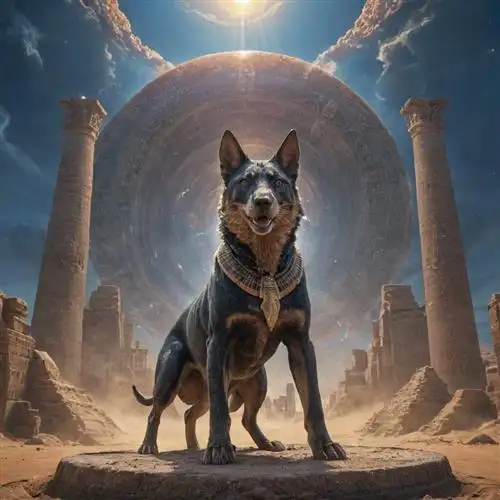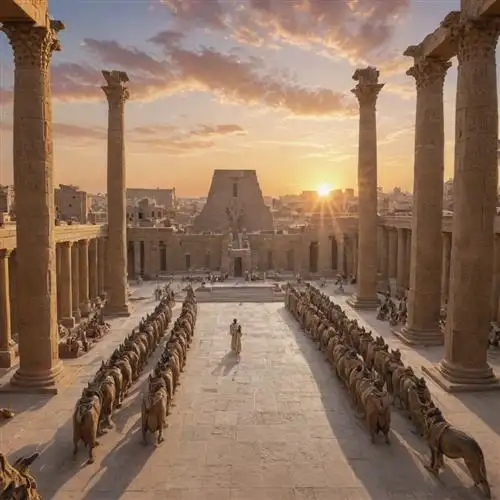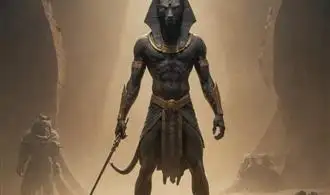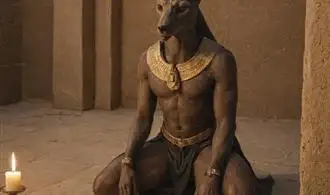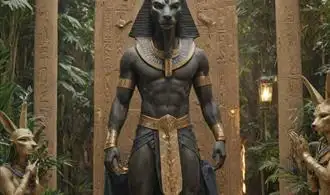
The Origins of Anubis
Anubis, the enigmatic jackal-headed deity, has captivated the minds of scholars and enthusiasts alike for centuries. This revered Egyptian god, whose origins can be traced back to the dawn of ancient Egyptian civilization, holds a significant place in the pantheon of deities. Delving into the rich tapestry of his origins reveals a complex and multifaceted narrative that sheds light on the ancient Egyptians' profound understanding of the natural world and their beliefs about the afterlife.
The earliest known depictions of Anubis date back to the Predynastic period, around 3100 BCE, where he was associated with the embalming process and the protection of the dead. This connection to the funerary rites and the afterlife is a testament to the pivotal role Anubis played in the ancient Egyptian worldview. As the god of the necropolis, he was responsible for guiding the deceased through the treacherous journey of the afterlife, ensuring their safe passage and transformation into the next stage of existence.
Interestingly, the origins of Anubis's iconography and the choice of the jackal as his animal form are the subject of ongoing scholarly debate. Some scholars argue that the jackal was selected due to its association with cemeteries and its scavenging behavior, which was observed near the burial sites of the ancient Egyptians. This connection to the physical remains of the deceased further solidified Anubis's role as the guardian of the dead and the embalming process.
Another intriguing aspect of Anubis's origins is his potential connection to earlier, pre-dynastic funerary deities. Some researchers have posited that Anubis may have evolved from earlier jackal-like deities, such as Wepwawet, who also shared a close association with the necropolis and the afterlife. This potential lineage highlights the dynamic and evolving nature of the ancient Egyptian pantheon, where deities could merge, diverge, or transform over time to meet the changing needs and beliefs of the people.
Furthermore, the cult of Anubis was not limited to a specific geographic region but was widespread throughout ancient Egypt. His temples and shrines were found in various important necropolis sites, such as Abydos and Saqqara, underscoring his significance in the funerary and mortuary rituals of the ancient Egyptians.
The Role of Anubis in Egyptian Funerary Rites
Anubis, the jackal-headed god of the ancient Egyptian pantheon, played a pivotal role in the elaborate funerary rites and rituals that were central to the belief systems of this ancient civilization. As the god associated with mummification and the protection of the dead, Anubis was a crucial figure in the journey of the deceased from this life to the afterlife.
One of the primary responsibilities of Anubis was to oversee the mummification process, ensuring the proper preservation of the body and the removal of the internal organs, which were then placed in canopic jars. This meticulous procedure was essential, as the Egyptians believed that the body needed to be intact for the soul to return and reside within it during the afterlife.
Anubis was also tasked with guiding the soul of the deceased through the arduous journey to the afterlife, known as the Duat. During the funeral rites, Anubis would be present to weigh the heart of the deceased against the feather of truth, a symbolic representation of the individual's moral and ethical conduct during their lifetime. This critical moment, known as the "Weighing of the Heart," determined whether the soul would be permitted to enter the afterlife or be condemned to eternal torment.
Additionally, Anubis played a vital role in the rituals and ceremonies surrounding the mummification and burial of the deceased. He would be present during the opening of the mouth ceremony, where the deceased's senses were "awakened" to enable them to partake in the offerings and activities of the afterlife. Anubis would also be invoked to protect the deceased's tomb and its contents, ensuring the safe passage of the soul to the Duat.
The importance of Anubis in the Egyptian funerary rites cannot be overstated. As the god responsible for the preservation and protection of the dead, Anubis was central to the Egyptians' beliefs about the afterlife and the journey of the soul. His presence in the mummification process, the Weighing of the Heart, and the various burial rituals underscores the profound significance of this enigmatic figure within the rich tapestry of ancient Egyptian religious and cultural traditions.
The Symbolic Significance of Anubis's Iconography
Anubis, the jackal-headed Egyptian deity, is a complex and multifaceted figure whose iconography is rich with symbolic meaning. As the god of embalming and the protector of the dead, Anubis's physical representation holds profound significance within the ancient Egyptian belief system.
The jackal head of Anubis is not merely a distinctive feature but a deliberate choice that aligns with his divine responsibilities. Jackals were often observed near burial sites, scavenging on the deceased, and this association led the ancient Egyptians to revere the jackal as a symbol of the afterlife. Anubis's canine-like head, therefore, represents his role as the gatekeeper between the world of the living and the realm of the dead.
Furthermore, the black color of Anubis's skin is equally symbolic. Black was considered a color of regeneration and rebirth in ancient Egyptian mythology, as it was associated with the rich, fertile soil of the Nile River. This connection to the life-giving properties of the earth reinforces Anubis's role as the guardian of the deceased, ensuring their successful transition to the afterlife.
Anubis's iconography often depicts him holding the was scepter, a symbol of power and dominion. This scepter is a visual representation of Anubis's authority over the process of mummification and the rituals surrounding the dead. The was scepter also signifies Anubis's ability to guide the deceased through the challenges of the afterlife, ensuring their safe passage to the next world.
In addition to the was scepter, Anubis is frequently depicted holding the ankh, the iconic Egyptian symbol of life. This duality of holding both the was scepter and the ankh symbolizes Anubis's ability to bridge the gap between life and death, guiding the deceased through the transition and ensuring their continued existence in the afterlife.
The Cult of Anubis and Its Cultural Impact
The cult of Anubis, the ancient Egyptian god of the dead, held immense significance in the rich tapestry of Egyptian culture. Anubis, often depicted as a jackal-headed deity, was responsible for the crucial process of mummification, guiding the dead through the afterlife and ensuring the preservation of their mortal remains. This pivotal role in the Egyptian funerary tradition elevated Anubis to a position of paramount importance within the pantheon of Egyptian gods.
The cult of Anubis was centered in the city of Cynopolis, where the god was venerated as the patron deity. Devotees of Anubis would gather in his temples to perform rituals and seek his guidance in the afterlife. The priests of Anubis were highly revered, responsible for the meticulous process of mummification and the preparation of the deceased for their eternal journey.
Beyond the religious significance, the cult of Anubis had a profound impact on the cultural and artistic expression of ancient Egypt. The imagery of Anubis, with his distinctive jackal-like features, became ubiquitous in Egyptian art, adorning tombs, sarcophagi, and a myriad of sacred objects. These representations not only served a symbolic purpose but also showcased the remarkable technical and artistic prowess of the ancient Egyptian craftsmen.
The cultural influence of the cult of Anubis extended beyond the boundaries of ancient Egypt, as it spread to neighboring civilizations. The Greeks, for instance, identified Anubis with their own god of the dead, Hermanubis, a syncretic deity that combined the attributes of both Anubis and Hermes. This cross-cultural exchange further solidified the enduring legacy of the Anubis cult and its impact on the ancient world.
The reverence for Anubis also manifested in the funerary practices of the ancient Egyptians. The jackal-headed deity was often depicted guarding the entrances to tombs, ensuring the safe passage of the deceased into the afterlife. Mummification rituals, which were central to the cult of Anubis, became a defining feature of Egyptian funerary rites, cementing the god's role as a protector and guide for the dead.
Modern Interpretations and Influences of Anubis
In the realm of ancient Egyptian mythology, the figure of Anubis has endured as a captivating and multifaceted deity. While Anubis is perhaps most widely recognized for his role as the god of the dead, his influence and interpretations have evolved over time, extending far beyond the confines of the ancient world. In this exploration, we delve into the surprising secrets and modern interpretations of Anubis, shedding light on the ways in which this enigmatic deity continues to captivate and inspire.
One of the most intriguing aspects of Anubis' modern interpretations is the way in which he has been embraced by various cultural and spiritual movements. In the realm of Wicca and neopaganism, for instance, Anubis is often venerated as a guardian of the underworld and a guide for those seeking to commune with the spirit world. This association with the mystical and the occult has contributed to a resurgence of interest in Anubis, as individuals seek to tap into the power and wisdom that this deity is believed to embody.
Moreover, Anubis has also found a place in contemporary art and popular culture. His distinctive jackal-headed visage has become a recognizable symbol, appearing in film, television, literature, and even fashion. This visual representation of Anubis has led to a deeper exploration of the deity's symbolism and the ways in which his mythology can be interpreted and reinterpreted for modern audiences.
One particularly fascinating aspect of Anubis' modern influences is the way in which he has been incorporated into various spiritual and metaphysical practices. In some New Age and alternative healing modalities, Anubis is invoked as a protector and guide, offering assistance in navigating the transition from life to death. This has led to the development of Anubis-centric rituals and meditations, where practitioners seek to harness the energy and wisdom of the jackal-headed god.
Additionally, Anubis has also found a place in the realm of Jungian psychology and depth psychology. Analysts have drawn parallels between Anubis' role as a psychopomp, or guide of souls, and the psychological concept of the "shadow self" – the hidden or repressed aspects of the human psyche. This connection has inspired further exploration of Anubis as a symbol of the unconscious mind and the transformative power of confronting one's own darkness.

